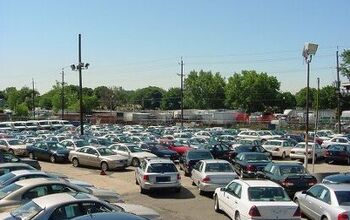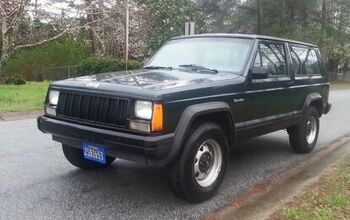Hammer Time: Behind The Gavel
Auto auctions are unique creatures. There are endless lines of cars going in and out of the lane. Auctioneers using their powers of persuasion to create the urgency to buy. Alliances. Egos. Organized chaos at every moment… and most of all a reserve price that has to be met come hell or high water. There is one unique twist to today’s auto auction world. Many buyers and sellers will never come to the auction. They are online. Viewing all the sales and inventory for the week on a computer. Which brings to me the first company featured in this three part installment:: Insurance Auto Auctions.
You would think that a name like Insurance Auto Auctions would pretty much explain everything they do. They sell what you crash. About a decade or so that was pretty accurate. Today it’s the enthusiasts version of a smorgasbord. Anywhere from a Rolls Royce, to a Maserati, to a Murilee Martin find can be had at their sales. 1.25 million units were sold overall in 2010 at 159 different facilities. Many of which had clean titles and were ready to drive out. Not only cars. But motorcycle’s, ATV’s, RV’s, watercraft, scooters, trailers. Pretty much anything that can have a motor connected to it. Click here for a sample of their inventory or here for a tutorial.
IAA uses a hybrid model to sell their vehicles. An auctioneer is there for the live sale along with simultaneous online bidding. It’s a similar model to most other competitors in the business. Except that IAA has more of an international clientele. 30% of their inventory is sold to foreign buyers with a near 50/50 split between lane bidding and online bidding. These international buyers require easy importation laws and affordable tariffs and thanks to today’s market forces, that has now become a reality. Even if you never come attend an auto auction, you will enjoy lower insurance rates and far fewer ‘Frankensteins’ on American roads thanks to the international scope of this market.
These international buyers will have U.S. contacts who usually prefer to have live bidding and viewing. The computer screen can only provide so much information and IAA has to sell nearly 25,000 units a week. Every week. That must get everything from titles, to paperwork, to condition reports, to run numbers. It’s a momentous task that results by necessity in a more hands-off approach with inspections. It is the golden rule of all auto auctions where high stakes and high risk are a given… you better know what you’re doing. Your ‘education’ will always come from your mistakes, and we all make them.
Even the ones that may buy 50 to 70 units a week will have people on the ground inspecting the inventory beforehand. In developing countries there is a strong demand for affordable transportation. Especially if that transportation is spec’d out like the typical American car.
Premium sound systems, Satellite and navigation systems. Advanced variable-timed engines and power everything may be standard and expected options in our market. But in developing markets that’s simply not the case. Even air conditioning was hard to come by until recently in most counties. This opportunity to sell this type of premium product translates into a lot of healthy competition at IAA’s auctions. The dealer from Belarus will indeed compete with the ones from Bolivia and the United Arab Emirates when that late model Toyota Camry is ready for sale.
In the next installment, I will focus on the dealer side of the equation. What it takes to bring a smashed, trashed, or even a clean vehicle through all the red tape and ‘distribution channels’ of their home countries. It’s not an easy task… and getting the cars into the country is surprisingly the easy part of the process.
More by Steven Lang
Latest Car Reviews
Read moreLatest Product Reviews
Read moreRecent Comments
- Jeff Self driving cars are not ready for prime time.
- Lichtronamo Watch as the non-us based automakers shift more production to Mexico in the future.
- 28-Cars-Later " Electrek recently dug around in Tesla’s online parts catalog and found that the windshield costs a whopping $1,900 to replace.To be fair, that’s around what a Mercedes S-Class or Rivian windshield costs, but the Tesla’s glass is unique because of its shape. It’s also worth noting that most insurance plans have glass replacement options that can make the repair a low- or zero-cost issue. "Now I understand why my insurance is so high despite no claims for years and about 7,500 annual miles between three cars.
- AMcA My theory is that that when the Big 3 gave away the store to the UAW in the last contract, there was a side deal in which the UAW promised to go after the non-organized transplant plants. Even the UAW understands that if the wage differential gets too high it's gonna kill the golden goose.
- MKizzy Why else does range matter? Because in the EV advocate's dream scenario of a post-ICE future, the average multi-car household will find itself with more EVs in their garages and driveways than places to plug them in or the capacity to charge then all at once without significant electrical upgrades. Unless each vehicle has enough range to allow for multiple days without plugging in, fighting over charging access in multi-EV households will be right up there with finances for causes of domestic strife.


































Comments
Join the conversation
Interesting article, I appreciate your coverage of the auction world, which most of us would never read about.
Great article, Steven. Was in Cambodia a few weeks ago, and nearly all the cars there are U.S. spec. Most popular are '91-01 Camrys and Corollas, '00-04 Landcruisers for the well-heeled, which are badge-engineered to become Lexus 470s. A smattering of Asian-spec Fords and Chevys, even a couple of Hummer H3's. A local said Cambodians believe that left-hand drive American Toyotas are viewed as the best quality, superior to Toyotas made in Japan or Thailand. Even Canadian-spec Camrys (w/KM speedos) are rejected, as they're not "American" cars.